|
QUEENSLAND
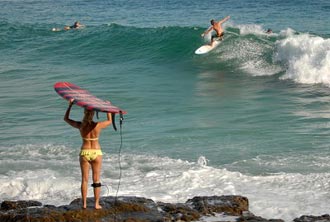
Noosa
The majority of the 7400 KM Queensland coast is blocked of swell by the Great Barrier Reef and other islands. There are some places were small choppy waves may make it to the coast, but the good ol' Box Jellyfish ( yes! it can and does kill ) makes surfing hardly worth the risk. There are waves on the outer reef, but seriously, its out of the scope for the normal traveller without a large boat to camp on. Agnes Water is Queensland's most northerly beach, which is where surfing in Queensland begins. Fraser Island is a large sand island with good beach breaks and works Southward. A 4WD vehicle (and permit) is essential to get onto the island and explore the long beaches. Surfing is best in the Summer - Autumn months, but the island does get waves all year round. South from Fraser Island and back on the mainland begins the Sunshine Coast. The sunshine coast has some consistent summer / autumn beach breaks and in the Noosa Heads area some classic point breaks that come alive during cyclone season (Dec-Mar). Winter can bring long flat spells to these areas. Brisbane, Queensland's capital lays on a bay, but surfing on nearby Stradbroke Island's beaches can get good. The area does have a reputation for sharks. Southwards again and stretching to the New South Wales border is the Gold Coast with its famous point breaks like Kirra and Burleigh Heads, like Noosa these are best during the cyclone season.
VICTORIA
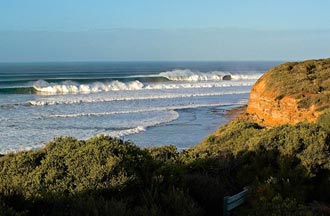
Bells Beach
South from the New South Wales border the Australia coastline takes are sharp turn to the SW. This opens the coast up to large winter swells generated in the Bass Strait and the Southern Ocean, but also means that tropical swells from cyclones and the such do not reach this coast. From the NSW border to Lakes Entrance is a stretch of largely untouched virgin coastline. Lakes Entrance marks the start of Ninety Mile beach, which does get waves. After Ninety Mile beach there is another stretch of wild coast in the Wilson's Promontory area. Sandy Point (Just before Wilson's Prom) has a lovely beach break that gets swell most of the time, especially in the Autumn to Spring period. Phillip Island further west has great beach breaks and some point breaks. Mornington Peninsula runs from the east side of Port Phillip bay up towards Melbourne. The very southern tip faces into Bass Strait and has some rather good beach breaks. Port Phillip Bay itself is not for serious surfing, so Melbourne surfers generally head SW to Queenscliff and from there the coast runs southwards to the classic Bells Beach. Bells is only one of a number of waves in the area, many are better. Most work best in the Autumn - Early Spring months, but smaller waves will occur over Summer as well. Bells to Apollo Bay has many breaks, both beach and rock. Most can be checked as you drive along. From Apollo Bay and Cape Otway, there are quite a few surf breaks, but local knowledge is necessary to surf the best. From Warrnambool to Portland and onwards to the South Australian border, you will find waves if you are prepared to get off the highway and search. The water may be cold, but the action can be hot.
WESTERN AUSTRALIA
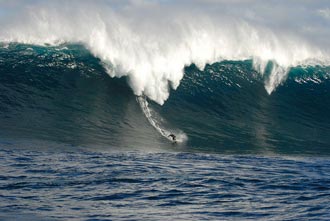
Cow Bombie, Margaret River
The cliffs of the Great Australia Bight near Eucla mark the beginning of the WA coastline. A beach at Eucla is just what the doctor ordered after a hot Nullarbor drive. From here to Esperance via the coast there is little access unless you have a 4WD and are well provisioned for the desert and isolation. For normal travellers you will have to leave the coast behind for the next 300 miles until Esperance. The coast between Eucla and Esperance is open to swell, but it is wild, there are no roads, towns or water. Esperance is located on the southern coast on West Australia, there is lots of potential. The ocean in the Esperance area is full of hundreds islands and reefs, you will notice bombies breaking white water right out on the horizon.
West from Esperance the coast gets greener but access to the surf is still limited to isolated small towns, each with its own breaks. There has to be miles of untapped waves here. Albany is located near the SW corner of West Australia and is open to everything the southern ocean can throw at it, some of the largest waves to ever hit the Australian continent probably do so in this area. At Augusta the coast turns north towards the famous Margaret River area, which has some of Australia's most challenging surf. A small day here is 5ft. From Margaret River towards Perth the swell is somewhat blocked by offshore reefs and Rottnest Island. Rottnest Island itself is a popular spot with the Perth locals and is often 2-3ft larger then Perth's beaches . Perth itself is largely small mushy beach breaks. North from Perth the coast again becomes rather wild and unsettled. Waves are to found anywhere you can get to the coast. Geraldton and Kalbarri are two areas that have excellent waves and weather. The coast from Kalbarri to North West Cape has waves made famous in surf movies, it is wild harsh coast and a 4WD is a must. Local knowledge is also a must. The same swells that hit Bali also strike this coast. From North West Cape northwards surf potential disappears as the coast swings north east away from swell generating systems and offshore barrier reefs start.
|
NEW SOUTH WALES
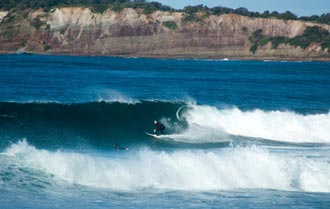
South Narrabeen
Practically the entire NSW coastline is surfable. Southwards from the Queensland border to Byron Bay there are a number of great beach and point breaks. Like Queensland these turn on best in Summer and Autumn. Byron Bay is Australia's most easterly point, the significance of this is that from here south the coast is more open to some winter swells generated in the deep south of the Tasman Sea between Tasmania and New Zealand. The North Coast of NSW is home to some classic point setups such as Lennox and Angourie, but there are many others for anybody willing to search. The beaches are usually good value as well. Moving further south and Coffs Harbour marks the start of the mid north coast. Coffs Harbour itself has lots of beach breaks. The Mid North Coast is similar to the North Coast in geography with beaches and points. Some of the better known areas are Crescent Head and Port Macquarie. Southwards again begins the Central Coast and Hunter. We are now getting far enough south that winter ground swells from the Tasman Sea can start making their presence felt, and surfing is generally good all year round Newcastle is home to Mark Richards and some very good beach breaks as well. The area from Newcastle to Sydney is known as the Central Coast, there is a multitude of beach and reef setups. . I hardly have to tell you about Sydney. Sydney is blessed with scores of surfable points and reefs. Dee Why, Narrabeen, Cronulla, Bondi you have heard the names no doubt and the waves are there, but it does get very crowded at times with locals being on the psychotic side of things at times. Heading south from Sydney begins the south coast, the first section around Wollongong to Shell Harbour is still built up. There are some classic points in the area. Sandon Point, Windang Island and The Boneyard at Kiama will all handle waves well over 12 ft. Further south and the coast gives way to isolated towns and a largely undeveloped coastline. There are still "secret spots" on the south coast. Waves such as Black Rock and Merimbula Bar rival any in the world for quality.
SOUTH AUSTRALIA
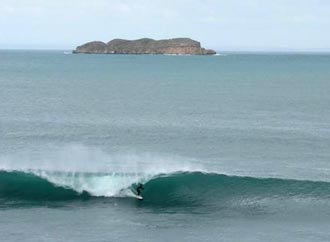
Chinamans, York Peninsula
The first part of the South Australia coast from the border to Kingston SE is very similar to Victoria's southern coast. Lots of limestone reefs with beaches between. But again you will need to explore. This coastline is also right open to the southern ocean. From Kingston SE the coast swings NW and is mostly a large unbroken beach, surfing potential is limited by access (there are very few places to access the beach and a 4WD is necessary) and size usually decreases the further north you move. This beach ends at Victor Harbour and in this area there are reef and beach breaks, although Kangaroo Island can block swell. Adelaide, South Australia's capital is located on the Gulf of St Vincent, although it can get small choppy waves it isn't really a serious destination. Adelaide's surfers usually head for the tip of Yorke Peninsula, where there are some good reef / point setups. Spencer Gulf separates Yorke Peninsula from Eyre Peninsula. The southern and western coasts of Eyre Peninsula offer a variety of reef, point and beach breaks. Many breaks need a 4WD to get to. There are some closely guarded classic setups along this coast. Many of the waves are quite powerful and are not to be underestimated. West of Ceduna is the famous Cactus Beach breaks, the well known breaks are only some of several in the area. The country is harsh and 40+ Degree land temperatures can combine with 25+ Degree water temperatures. There is only one type of shark in this area, Great Whites and they are not friendly. The surf ends at the Nullarbor Plain, not due to lack of swell, but due to 200 miles of unbroken cliff which stretches to the West Australia border.
TASMANIA
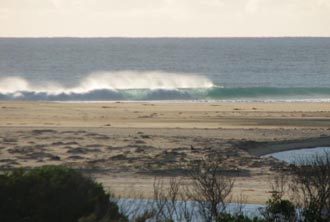
Scamander Beach
This often overlooked surf destination does actually get very good waves. On the west coast your problem will be firstly getting a day small enough, then getting one that isn't onshore. In late summer / early autumn offshore days can occur in combination with moderate swells. Only the top one third of the west coast is accessible, even then only at certain locations. The south west is totally wild and remote, no doubt there is waves and perhaps some classic reefs, but they will probably remained unsurfed for many years yet. The Northern coast of Tasmania is somewhat protected and lengthy flat spells, especially in summer can occur, however Bass Strait can be one of the roughest stretches of water around and waves large enough to surf are often generated within the strait itself. The east coast is again open to the ocean, the Tasman Sea, it does get good waves especially after winter lows pass into the Tasman Sea. Moving further south to the Hobart area and big waves are found in the Port Arthur area. Hobart itself is located on a large bay, but swells do sometimes work right up into it.
NORTHERN TERRITORY
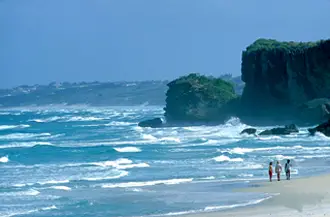
Baringura (Little Bondi), Arnhem Land
The Territory isn't usually touted for its surf beaches, but unbeknownst to many, it does have its fair share of avid surfers, who claim there are 200 or so surfing 'hot spots' dotted around the Top End coast line, including Baringura, that is so popular amongst the surfing fraternity it's known as "Little Bondi" on the Arnhem Land coast. In spite of the threat of catching tubes alongside stingers and crocs, on any day during the Wet Season - and sometimes even in the Dry - you can spy surfers on breaks around Mindil Beach, Nightcliff Beach, East Point and Casuarina, near Darwin. Statistically crocs don't pose the same threat to Top End surfers that sharks do Down South, with one of the biggest threats to safety being the "short wave" action unique to the region, and getting dumped by strong tides. The advice therefore is, when surfing in the Territory, always wear protective clothing.
|